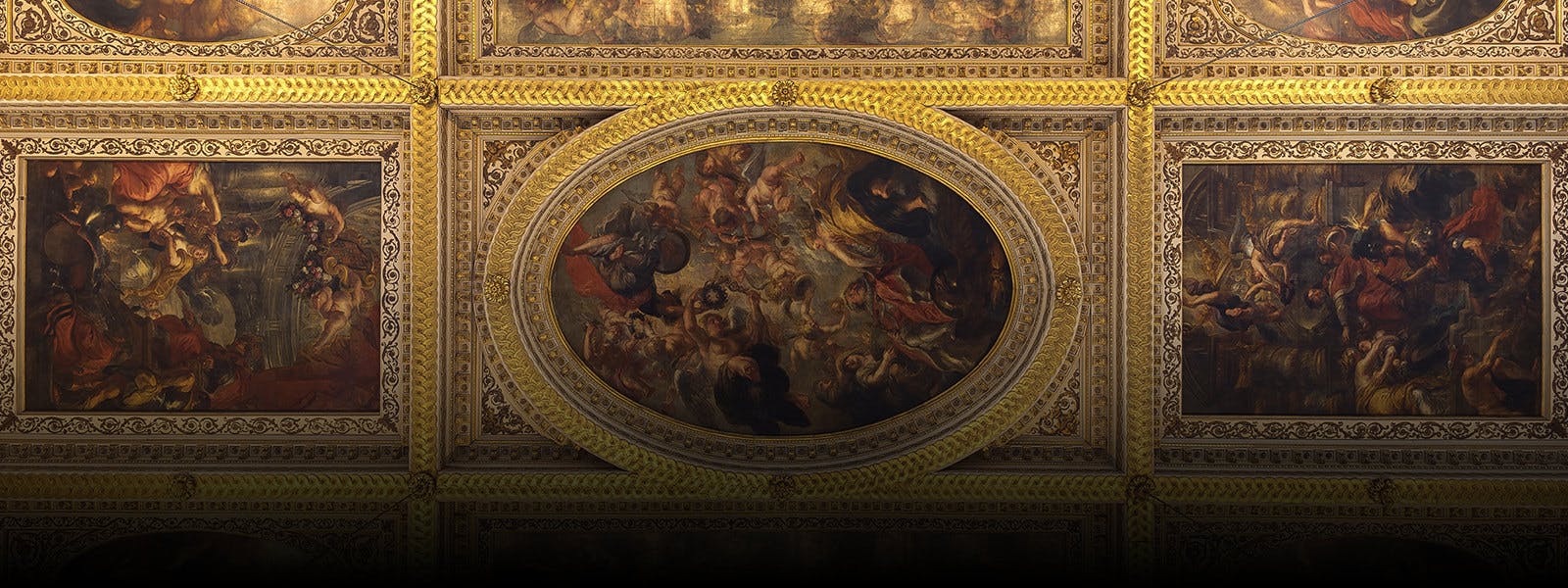
The crowning glory of the Banqueting House
The Power and the Glory
This huge oil painting by Peter Paul Rubens adorns the ceiling of the Banqueting House and was commissioned by Charles I as testament to the glory of the Stuart monarchs.
Banqueting House is the only remaining complete building of Whitehall Palace, the sovereign's principal residence from 1530 until 1698 when it was destroyed by fire.
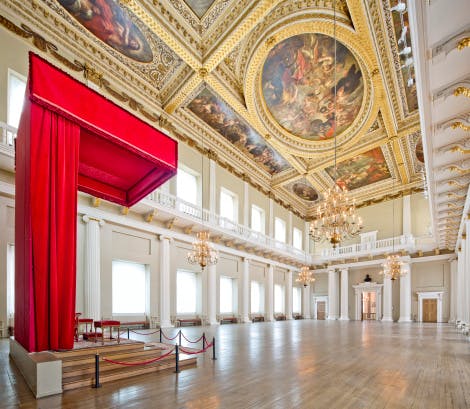
Image: Great Hall at Banqueting House. © Historic Royal Palaces
The grand scheme
This magnificent painting by Peter Paul Rubens remains the largest surviving work by the Flemish artist still in its original location in Europe.
It was commissioned in 1629 by Charles I, although Rubens had originally been approached about the project by James I before the King died in 1625.
The subject of the painting discussed was to be a celebration of the magnificent reign of the Stuart king.
The perfect frame
In anticipation of the commissioned painting, Inigo Jones, the architect of the Banqueting House, had designed a great beamed ceiling with blank squares, rectangles and ovals, ready to take enormous decorated canvases.
The paintings were completed by Rubens in 1634, and finally installed in the ceiling of the Banqueting House in early 1636.
Did you know?
Peter Paul Rubens was both a high-ranking diplomat and one of Europe’s most celebrated artists.
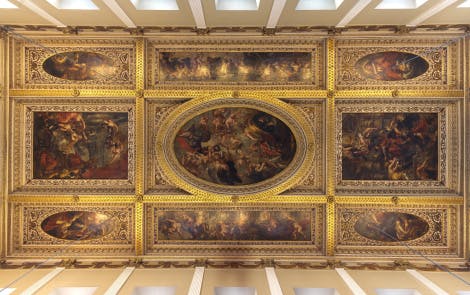
Image: Rubens ceiling at the Banqueting House.© Historic Royal Palaces. Image by Google.
A challenging commission
The ceiling presented a huge challenge for Rubens. Never before had he worked on such a scale. The total painted area equalled 225 square metres (2420 sq ft).
The three largest canvases were too big to be painted in his studio in Antwerp. Rubens and his small army of assistants (who painted the less important bits, such as the armour) had to work instead in the Antwerp Exchange and the refectory of a nearby Carmelite convent.
A measuring mix-up
When the paintings were finished they were rolled up for storage before shipping to England. However, Rubens’ illness and other factors delayed this for nearly a year, by which time the paint had started to crack. A spot of re-touching later and the paintings were on their way.
When the canvases arrived in England and were first unrolled on the floor, Inigo Jones and Rubens’ assistants realised with mounting horror that a miscalculation meant they were the wrong size to fit the ceiling spaces!
Did you know?
The mix-up happened because although both England and Belgium used feet and inches, these were of different lengths in each country!
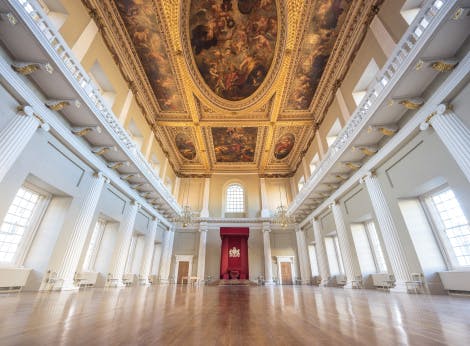
Image: © Historic Royal Palaces
Paying the bill
After trimming some and expanding others, the paintings were finally installed. Charles I declared himself delighted.
Following an initial two-year delay, Rubens received £3,000 (the equivalent of £218,000 today) and a heavy gold chain as payment for his work.
A final irony
Rubens suffered painful gout, which prevented him from travelling to England. He never saw his paintings installed.
However, his royal patron Charles I must have reflected bitterly on their subject matter, the Divine Right of Kings. The ceiling painting, glorifying the monarchy and showing his father ascending to heaven surrounded by angels, was one of Charles’ last sights on earth as he walked beneath it to his death.
Having lost the Civil War to the Parliamentarians, the King was executed on a specially-built scaffold just outside Banqueting House on 30 January, 1649.
Did you know?
To save the painting from German bombs in 1941, the wood-backed canvases were hurriedly sawn into smaller segments and transported to the country.
Reading the ceiling
The three main canvases at Banqueting House depict the themes of the union of England and Scotland, the wise rule of the good King and the central idea of kings as gods on earth.
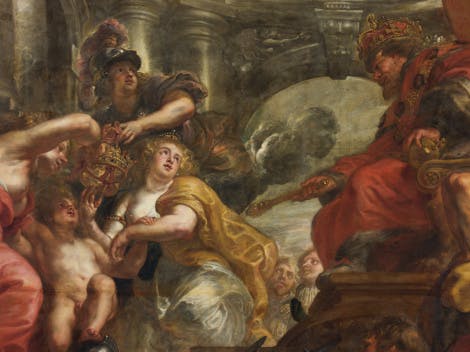
Image: The Union of the Crowns of England and Scotland c.1632-4. © Royal Collection Enterprises Limited 2024 | Royal Collection Trust
The Union of the Crowns
The goddess Minerva brings together the two crowns of Scotland and England over the head of a young child, who may represent Great Britain.

Image: The Wise Rule of James I c.1632-4of James I c.1632-4. © Royal Collection Enterprises Limited 2024 | Royal Collection Trust
The Peaceful Reign of James I
James I sits in a biblical-style setting that flatteringly suggests King Solomon, surrounded by figures represent abundance and wisdom.

Image: The Apotheosis of James I c. 1632-4. © Royal Collection Enterprises Limited 2024 | Royal Collection Trust
The Apotheosis of James I
The King, believed to be answerable to God alone, is carried up to heaven on the wings of a huge eagle.
Up Close: The Apotheosis of James I
The ceiling canvases were commissioned by James I's son, Charles I, in 1629-30, to celebrate his father's life and wise government. They represent the only scheme painted by Rubens to remain in its original position.
View this painting in high definition in this Gigapixel image, created in partnership with Google Arts & Culture.
Listen to the podcast
In this episode, Curator Lee Prosser takes us into a hidden space at the Banqueting House, once part of the great Whitehall Palace. It may not be the famous Rubens ceiling, but Lee will reveal how the roof space of the Banqueting House is a piece of living history, with a rich past and an important role for the future.
Listen to moreBrowse more history and stories
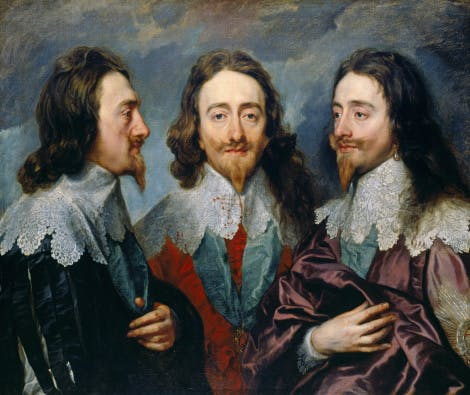
The execution of Charles I
Killing of a 'treasonous' King

The masque
A fabulously extravagant early 17th century court entertainment
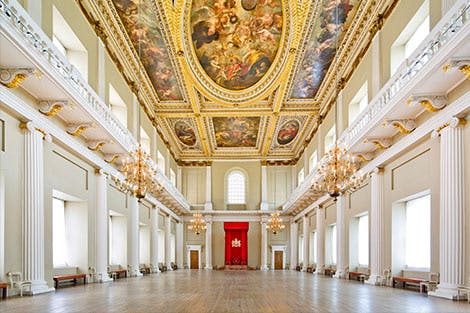
The story of Banqueting House
Four hundred years of history and the site of a royal execution
Explore what's on

- Things to see
The Undercroft
Explore the vaulted drinking den beneath the Banqueting House, which was used by James I for decadent royal parties.
- Closed
- Banqueting House
- Included in palace admission (Members go free)

- Things to see
Rubens ceiling
Marvel at Sir Peter Paul Rubens' ceiling in its original setting of Inigo Jones' spectacular Banqueting House.
- Closed
- Banqueting House
- Included in palace admission (Members go free)

- Things to see
Inigo Jones' architecture
Find out what remains of Whitehall – known as one of the first examples of Palladianism in British architecture.
- Closed
- Banqueting House
- Included in palace admission (Members go free)
